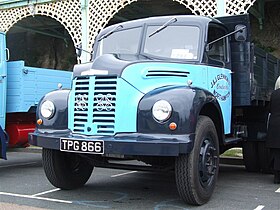Dodge 100 "Kew"
| Dodge 100 | |
|---|---|
 | |
| Overview | |
| Manufacturer | Dodge UK Renault Trucks (for supplies to Indian production) |
| Also called | Premier Roadmaster |
| Production | 1949-1957 (production in India continiued until the 1980s) |
| Assembly | Kew, United Kingdom Mumbai, India |
| Body and chassis | |
| Related | Leyland Comet Ford Thames ET6 |
| Chronology | |
| Predecessor | Dodge D15 |
| Successor | Dodge 300 |
The Dodge 100 "Kew" was a range of trucks made from 1949 until 1957 by the American Dodge company at their British factory in Kew, London.[1] The trucks were often nicknamed the "parrot nose" due to their distinctive shaped bonnets and grilles. Most of the trucks were powered by either Perkins diesel or Chrysler petrol engines. The cab body was built by Briggs Motor Bodies and was shared with the Ford Thames ET6 and Leyland Comet. They were featured in the 1957 film Hell Drivers.
In India, the same model was manufactured by Premier Automobiles Limited and production continued until the 1980s. Many were still in operation as of 2016 in some regions. Since the early 1970s it has been known as Premier Roadmaster for diesel versions and Pioneer for Petrol versions, otherwise simply known as Fargo.
Description

The first Dodge truck to be built in the United Kingdom was the Dodge D15. The Dodge D15 was based on the American Dodge VC-series, but was made for Canadian specifications and was also exported as knock-down kits to other Commonwealth Countries. These trucks were built in Kew in the UK. After the war, some of these trucks were still in service, and other were exported to countries such as Malta.
The Dodge 100 was launched in 1949, and was the second British-built Dodge medium-duty truck, succeeding the Dodge D15, and was based on the same technical layout.
The Dodge 100 truck has a cab built by Motor Panels that was also used on the Leyland Comet and Ford Thames ET6 trucks. The vehicle was also produced in India, where it was very popular, although it gradually fell in popularity, in favor of the more modern Bedford TJ trucks, that were produced by Hindustan Motors.
Production in the UK ended in 1957, being replaced by the Dodge 200 trucks, which were based on the Commer Superpoise models of 1957, although production in India continued from knock-down kits. When Renault Trucks took over the truck division of Chrysler Europe, exports of assembly kits to India gradually stopped, with production ending some time during the 1980s.
The 100 nameplate was later used on a completely different Dodge truck that beared the Commando name. With the exception of the Renault Trafic and Renault Master, Renault does not offer any conventional truck series as of now.
Gallery
-
1954 Fargo in New Zealand
-
Dodge Kew "Parrot Nose"
-
A Dodge 100 truck in classic vehicle show
-
A Dodge 100 converted into a bus in Finland
-
A Premier Roadmaster truck still in use as a workhorse





